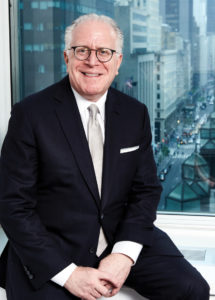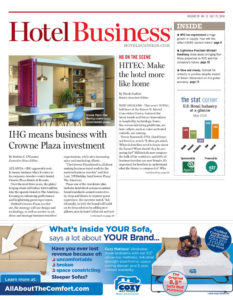 Lightstone, a real estate investor/developer, has partnered with Marriott International to bring four Moxy properties to the NYC market. They will he located in the city’s most prominent neighborhoods: Times Square, NoMad, East Village and Lower East Side. Hotel Business caught up with Lightstone President Mitchell Hochberg to chat about the company’s plans and outlook on the future.
Lightstone, a real estate investor/developer, has partnered with Marriott International to bring four Moxy properties to the NYC market. They will he located in the city’s most prominent neighborhoods: Times Square, NoMad, East Village and Lower East Side. Hotel Business caught up with Lightstone President Mitchell Hochberg to chat about the company’s plans and outlook on the future.
What are the main drivers behind the partnership with Marriott in NYC? We have a long-standing presence in New York City. There was an opportunity for unmet demand with longtime occupancy in the high 80% and low 90% range. We knew the cost to develop was prohibitive. The answer was to develop a product that is efficient. In other words, smaller hotel rooms that still deliver a unique experience.
We firmly believed it was beneficial to have the strength of a major brand behind the project. That is why we partnered with Marriott, with whom we have a strong, long-standing relationship. They are the best in the business, particularly with regard to their powerful reservation systems and rewards programs.
When we approached them, they were already working on Moxy in Europe. We told them we were confident Moxy could also be successful in the U.S., which leads us to today: We are in the midst of simultaneously developing four Moxy hotels in New York, one of which includes the brand’s flagship U.S. location in Times Square. We are also developing two Moxy hotels in L.A. and one in South Beach, Miami.
Lightstone focuses mostly on select-service properties, and Moxy takes that a step further with its micro-format. What does the modern guest want/expect out of an urban stay? When people travel—particularly in gateway markets such as New York, L.A. and Miami—they are not as concerned with the size of the room as they are with their overall travel experience. When people travel, their priority is not to stay in but to go out. Hotels can add to travelers’ experiences by providing socially activated public spaces for people to interact.
Here is another way to think about it: We’re taking a cruise ship and turning it on its side. Rooms are small but thoughtfully designed. People do not go on a cruise to stay in their rooms. They want to interact with others and explore the destination they are visiting.
We’ve targeted each of these preferences, all while keeping the price tag low. Our hotels will include food & beverage offerings. Travelers will not be sacrificing design for affordability. We’re working with leading design firms such as Yabu Pushelberg, the Rockwell Group and AvroKO to create special environments.
Aside from the huge increase in supply, there are many factors that affect NYC hotels: the strength of the dollar, foreign travelers, Airbnb, etc. How concerned are you? We’re not concerned. We see Moxy as the perfect antidote to Airbnb. This has been our proposition since day one. Airbnb has not had a significant impact on hospitality. In 2015, it only represented 5.5% of overall lodging demand. Guests who typically seek out Airbnb are not the same guests a hotel like Moxy would attract. Like extended-stay hotels, Airbnb guests typically stay for more than seven nights, and such hotels only represent 4% of hotel rooms in Manhattan. Also, Moxy rates are competitive to Airbnb’s, while offering many advantages. Moxy’s targeted rate in New York City is around $275 a night. If a traveler wants to stay in an Airbnb for that price, they would have to go to an outer borough, far away from the sites they want to visit. For the same price, they can be conveniently located in areas near popular attractions and major transportation lines. Moxy guests will have the option to book through Marriott’s reservations systems, get reward points, be assured they’re in a safe area with building security, multiple food & beverage options in the building, the opportunity to meet fellow travelers in socially activated spaces, and other amenities. Visitors will also know exactly what they’re getting when they book a stay at Moxy, as opposed to the unknown of an Airbnb.
The company recently launched an incubator fund to seek out and develop entrepreneurial deals. Tell me about it. Our main focus is to stay nimble and innovative, and to champion the next great idea. We are well-positioned to provide capital to real estate entrepreneurs who have the ideas but lack the connections and expertise to successfully bring them to market. That is why we are soliciting bold, innovative investment opportunities, particularly at the intersection of real estate and technology, where we see many opportunities. We developed the incubator based on the success of previous partnerships and a desire to find new, creative enterprises to expand the company’s business reach.
Ideal projects will range in size from $1 million to $50 million, and potentially viable ideas will be vetted by a team of researchers and analysts to determine their feasibility, scope and market need. We will consider real estate-focused proposals that may range from development opportunities, to bringing disruptive technology to the industry, to expanding the company’s footprint into a new market.
Are there other markets you see a lot of potential in? Yes. Not only are we building Moxy locations in New York, but we’re also targeting other gateway cities. We currently have two developments in L.A. and one in South Beach. While we’re focused on these gateway cities now, we are also looking into other urban markets like San Francisco, Boston and Seattle.
Gateway cities are becoming literal and figurative islands for the very wealthy. As a society, everyone will have to do more with less space. Innovations will arise at the intersection of modular construction, interior design and technology. The bottom line is, costs are becoming more unsustainable and developers need to be creative and innovative in order to deliver across all real estate sectors, particularly in hospitality and residential. HB

